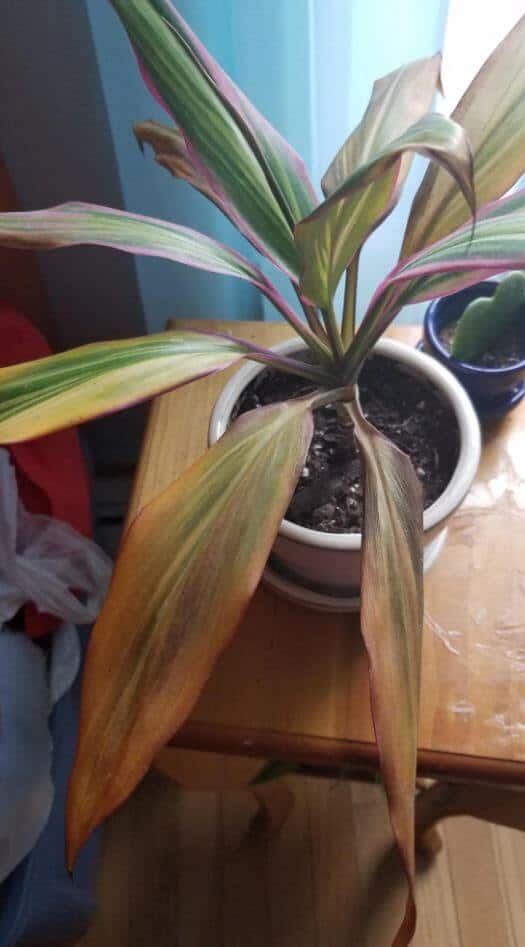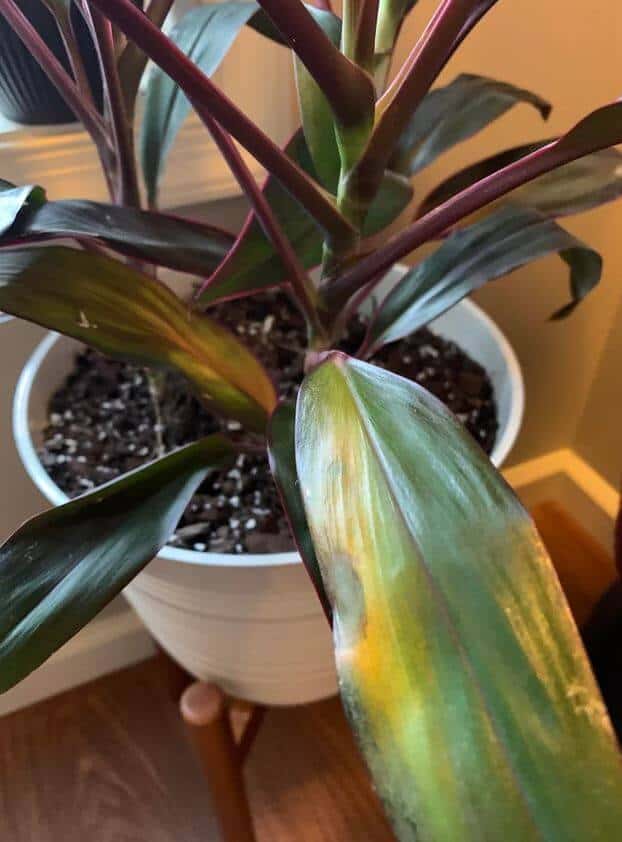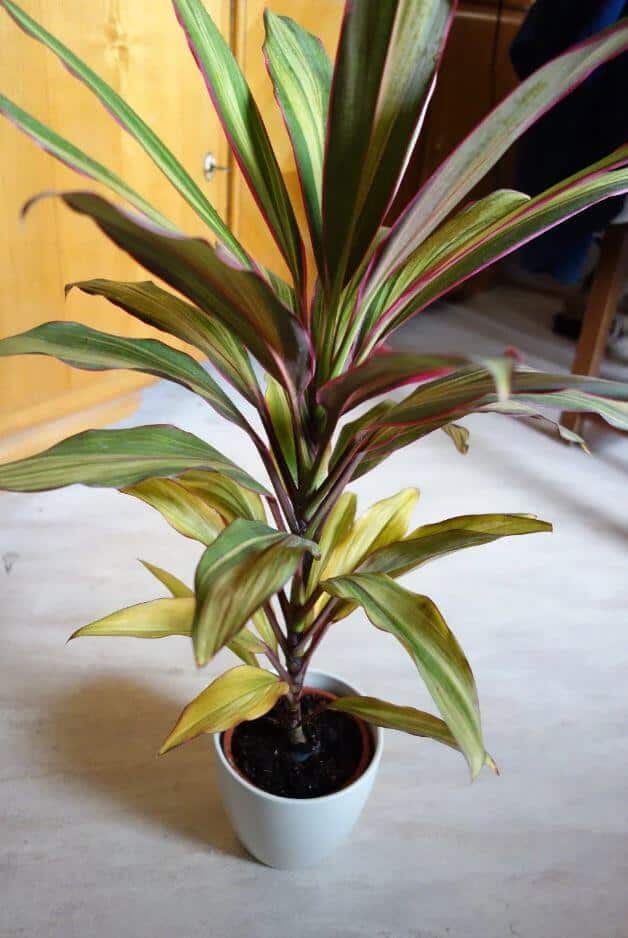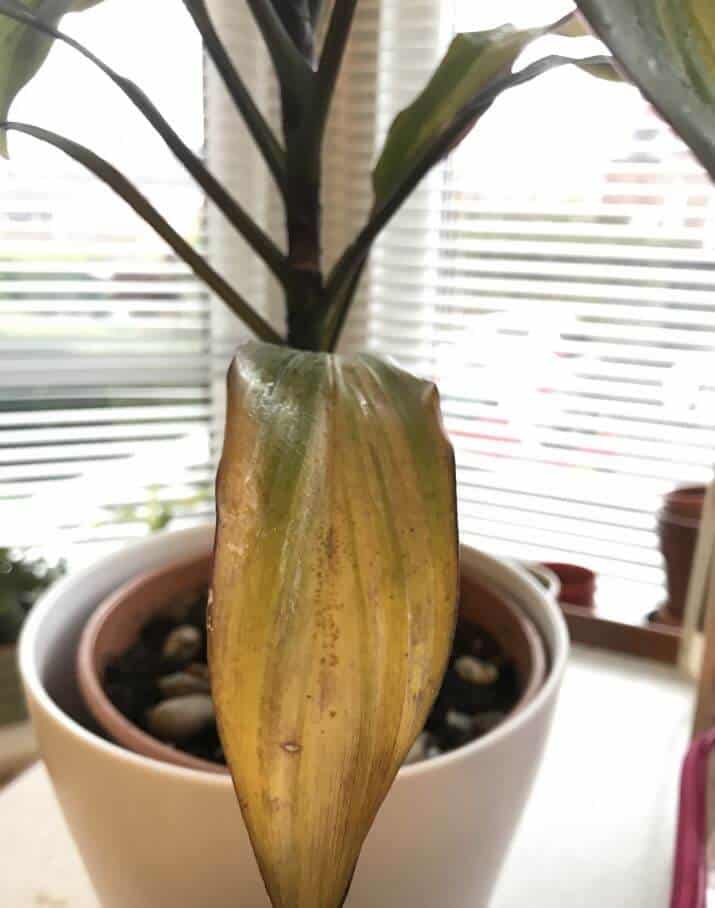Last Updated on January 26, 2023 by a Friendly Gardener
More commonly known as Hawaiian Ti plants, Cordyline plants are incredibly popular as houseplants. The Cordyline fruticosa is an evergreen plant that is a member of the Asparagaceae family. It is a favorite of indoor gardeners for its colored foliage but is also cultivated for use in traditional medicines, dyes, and food. Other popular names include the Palm Lily and the Cabbage Palm.
To keep your Cordyline plant beautiful, it will need some care. When a Cordyline plant is stressed or subject to environmental issues, the plant’s foliage may turn yellow as a reaction. To keep your Hawaiian Ti plant at its best, it’s best to be proactive in caring for it. Consider these stressors and how to safeguard your plant from developing health issues.
Cordyline Yellow Leaves

If your plant has yellowing foliage, check to see if any of these care practices may be the cause.
Watering Issues
Improper watering habits are a common cause of cordyline leaf problems. Whether there is too much water, too little water, or the water quality isn’t up to par, your cordyline plant may demonstrate its unease through its foliage.
• Excessive Watering
Yellow leaves are a common reaction by Cordyline plants that are overwatered. When the soil bed is waterlogged or soggy, this fact alone creates the perfect conditions for root rot to set in. As the root system rots it will cease to absorb nutrients and water that are essential for the plant’s health. Foliage will yellow and eventually drop off.
A Cordyline plant will only require water once or perhaps twice weekly and the soil bed should be almost completely dry. Most Hawaiian Ti plants will thrive with two waterings per week, but to be sure, you should always test soil moisture before watering. This can be done with a moisture meter or your finger. If the soil bed is still moist, hold off watering.
Soil quality should also be factored in, the Cordyline needs fertile, well-draining potting soil. Consider adding one part perlite to two parts potting soil when repotting.
• Insufficient Watering

A lack of water can also cause leaves to yellow. If you neglect your Cordyline plant or forget to water it, don’t be surprised if the foliage begins to yellow. In this case, give your plant a nice shower and let the plant sit until all the excess water has drained out. Afterward, return to a regular watering schedule.
• Improper Water Quality
Cordyline plants are known to be more sensitive to the quality of water used than many other houseplants. If your watering schedule is appropriate, the plant may be reacting to the water quality. If you are using municipal tap water, consider only watering your plant with collected rainwater. You can also try filtered, distilled, or spring water.
Insufficient Humidity
The Hawaiian Ti plant prefers an environment with moderate to high humidity levels. If they do not live in a spot with sufficient humidity levels, they will dry out and leaves can turn yellow. If you think a lack of humidity is to blame, use a space humidifier, or a pebble tray placed beneath your plant. Occasional misting will also help.
Insufficient Container Space and a Rootbound Plant

If your Cordyline plant has outgrown its container and is rootbound, leaves will be yellow. When a plant is rootbound, it has difficulty absorbing nutrients and water from the soil bed. Your plant may begin to wilt or droop, and leaves can turn yellow. Check your plant’s root system at least once annually. If the roots outgrow the container and peek from drainage holes or the soil surface, it’s time to repot in a larger-sized container. Select a pot that is a couple of inches larger than the old container. Also, feed your plant monthly during the growing season with a liquid 10-10-10 houseplant fertilizer to encourage healthy growth.
Temperature Issues
Hawaiian Ti plants find their native habitats in Southeastern Asia, Australia, and of course, Hawaii. They prefer an environmental temperature measuring between 60° and 85°F. If Cordyline plants are exposed to hotter temperatures, they can dry out and even be subject to burning especially if left near a heating unit or vent. Move your plant to a cooler spot if you suspect this is the cause of yellowing foliage.
Excessive Exposure to Sunlight

A Cordyline plant prefers bright but indirect sunlight. Some houseplants can tolerate full sun exposure, but many will suffer leaf scorching. Cordyline plant leaves turning brown or even crispy yellow leaves indicate your plant is receiving too much direct sunlight. Move your plant to a spot with bright indirect light and observe how it fares.
Natural Aging and Shedding
These plants are relatively fast-growing. As foliage ages, it will yellow and eventually turn brown before dropping. If you are providing proper care, your plant’s leaves may just be turning yellow and falling off due to natural aging. If you notice leaves that appear to be yellow from aging, trim them off with a clean pair of scissors. If foliage continues to be yellow, there is most likely another problem. If there is no further yellowing of foliage, it’s probably just aging.
What About Cordyline Fruticosa Leaves Turning Brown?
When a Cordyline’s leaves turn brown, this may be because of similar reasons for yellowing foliage. Hawaiian Ti plants feature colorful leaves, so when they turn brown, your plant is signaling that something is wrong. Some care issues can turn leaves brown or yellow. These include
- A lack of humidity
- Overwatering
- Underwatering
- Water quality
Underwatering may turn your Cordyline’s leaves a crispy brown while overwatering may be indicated by a mushy brown consistency. Water quality may be an issue if you use tap water. Collected rainwater is ideal for watering these plants. As tropical plants, Cordylines prefer a warm and humid habitat, so a lack of humidity or low humidity levels can cause leaves to turn brown or yellow.
A Final Thought

Cordyline plants are a beautiful addition to indoor home gardens. These evergreen plants are available in a variety of colors and will not enter unproductive periods of dormancy or die back in the winter, so you’ll enjoy a lovely plant year-round.


